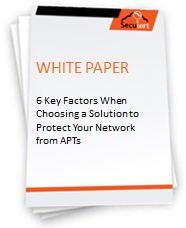Advanced Persistent Threats (APTs) represent an entirely new kind of security hazard. Unlike traditional viruses that infect as many victims as possible in the shortest period of time, APTs are persistent, recurring and targeted. They also take a “low and slow” approach, and are designed to steal and manipulate intellectual property over a period of months — even years.
What’s more, APT attacks aren’t just targeting traditional sectors (e.g. military, government, etc.). They’re also infiltrating networks in IT, energy, news, telecom, manufacturing, and the list goes on. Each day, more and more enterprises that once believed they were “completely protected” and “safely out of harm’s way” are discovering that their costly security perimeter simply can’t keep out APTs.
However, while the situation is dangerous and challenging, it’s certainly not hopeless.
While there’s no way to prevent 100% of APT attacks, there is a way to detect and defend against them. And the smartest way to achieve this critical objective is to choose an APT defense solution that:
- Uses Big Data and focuses on detection
- Allows for automated analysis
- Relies on a comprehensive and evolving malware datasets
- Is up and running within minutes
- Features an elastic data center platform
- Is measurably cost effective
To learn more about these essential criteria download our free White Paper, “The 6 Key Factors to Consider when Choosing a Solution to Protect Your Network”.
It’s a swift, informative and timely overview of what you need to know in order to keep your enterprise safe in today’s drastically more dangerous cyber threat landscape.




